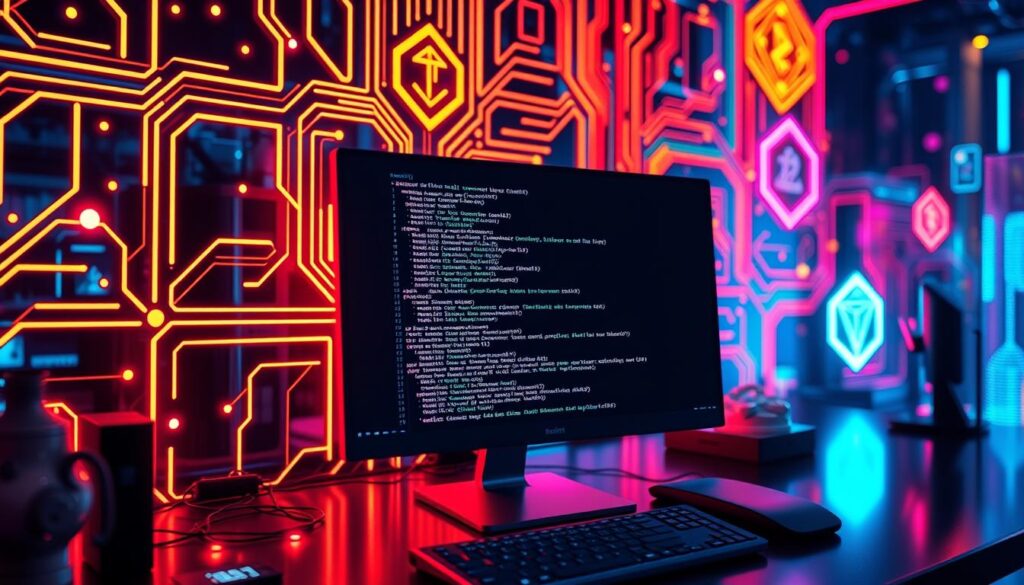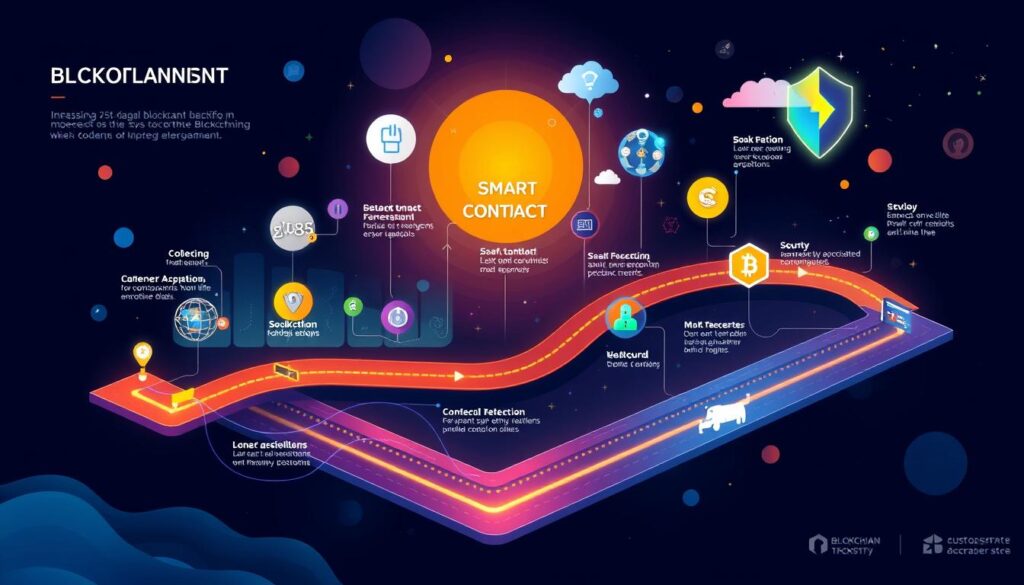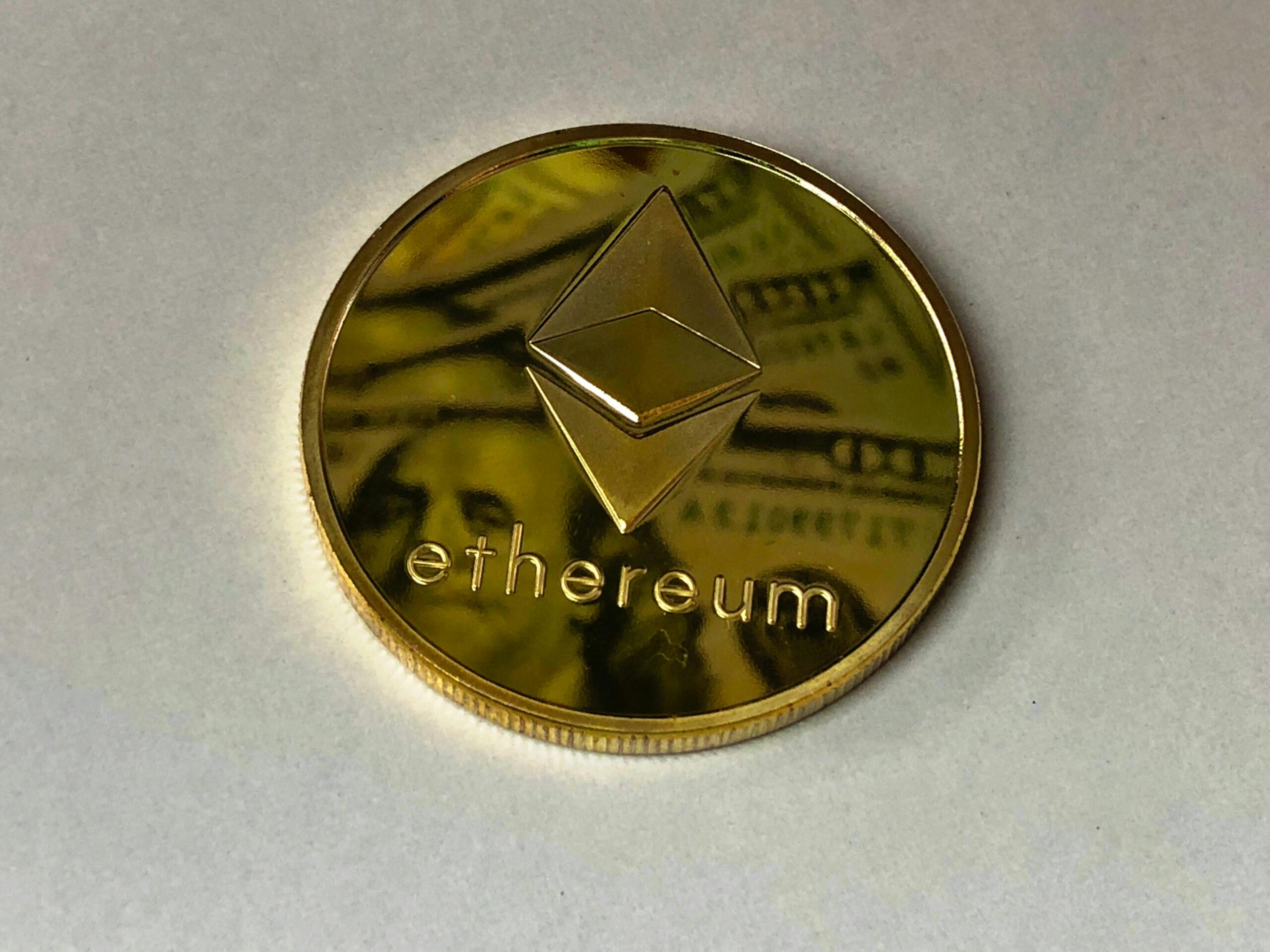Did you know the global blockchain market is expected to hit $67.4 billion by 2026? The world is embracing decentralized systems, and the need for blockchain developers is soaring. If you dream of entering this exciting field, you’re in the right spot.
This guide will walk you through the key skills, tools, and best practices for blockchain development. It doesn’t matter if you’re a seasoned programmer or new to tech. This roadmap will give you the tools to thrive in the fast-changing blockchain world.
Key Takeaways
- Understand the fundamental concepts of blockchain technology and its core components.
- Explore the essential programming languages and tools for blockchain development.
- Dive into the world of smart contracts, their security best practices, and deployment strategies.
- Gain expertise in Ethereum development, the leading blockchain platform for decentralized applications.
- Discover the various consensus mechanisms and their implications for blockchain networks.
- Learn how to build secure and scalable decentralized applications (DApps).
- Stay ahead of the curve by keeping up with industry trends and future blockchain advancements.
Ready to start your blockchain development journey? Let’s begin!
Understanding Blockchain Fundamentals
Starting your journey as a blockchain developer? It’s key to understand the basics of this groundbreaking tech. Let’s explore the core parts that make blockchain special and game-changing.
Distributed Ledger Technology Basics
At the core of blockchain is distributed ledger technology (DLT). This system logs transactions on many computers, making a secure, shared database. It’s different from old databases because it doesn’t rely on one person to control it. This makes it safer and more open.
Core Blockchain Components
The blockchain has several important parts. There are blocks, which hold transaction data; nodes, the computers in the network; and consensus mechanisms, which check and add new blocks. Together, they ensure the network is safe and reliable.
Cryptographic Principles
Cryptography is the heart of blockchain, keeping the network safe. It uses advanced methods like hashing and digital signatures to guard data. For any blockchain developer, grasping these cryptographic principles is crucial.
| Concept | Description |
|---|---|
| Distributed ledger technology | A decentralized database that records transactions across many computers in a network. |
| Blockchain | A type of distributed ledger that organizes data into interconnected blocks. |
| Cryptography | The practice of securing information using codes and ciphers to protect data integrity and privacy. |
“Blockchain technology has the potential to transform the way we think about trusted transactions and the management of assets.” – Don Tapscott, Co-founder and Executive Chairman of the Blockchain Research Institute
Essential Programming Languages for Blockchain Development
As a blockchain developer, knowing the key programming languages is crucial. These languages help in creating smart contracts and DApps on various blockchain platforms. Let’s look at the main programming languages needed for blockchain development.
Solidity
Solidity is a popular language for Ethereum smart contracts. It’s influenced by C++, Python, and JavaScript, making it familiar for many developers. Its syntax is perfect for complex smart contracts that automate business processes.
Vyper
Vyper is an experimental language for the Ethereum Virtual Machine (EVM). It’s known for its focus on security and auditability. Vyper’s simpler syntax makes it easier for Python developers to use.
Rust
Rust is a systems programming language gaining popularity in blockchain. It emphasizes safety, concurrency, and performance. Rust is great for building blockchain infrastructure and core components.
JavaScript
JavaScript is widely used in web development and is now in blockchain too. Frameworks like Ethereum’s Web3.js and Chainlink’s ChainlinkJS make it popular for DApps. Developers can use their JavaScript skills to create user-friendly interfaces and integrate blockchain.
| Programming Language | Key Features | Blockchain Applications |
|---|---|---|
| Solidity |
|
|
| Vyper |
|
|
| Rust |
|
|
| JavaScript |
|
|
These programming languages are key in blockchain development. Developers who know these languages can create innovative smart contracts and DApps. They will be ready to use blockchain technology to its fullest.
Getting Started with Smart Contracts
Blockchain technology has changed how we do digital transactions. Smart contracts are at the center of this change. They are self-executing digital agreements that are changing many industries. As a blockchain developer, knowing how to work with smart contracts is key.
In this section, we’ll cover the basics of solidity programming. We’ll also look at how to make sure your smart contract applications are secure and work well.
Solidity Programming Essentials
Solidity is the main language for Ethereum smart contracts. It’s a powerful tool for creating complex, decentralized apps. To master Solidity, you need to know its syntax, data types, and control structures.
Learning Solidity’s core concepts will help you create smart contracts that work well and are secure.
Smart Contract Security Best Practices
Security is very important for smart contracts. If there’s a problem, it can cause big issues. Developers need to follow best practices to stay safe.
This includes using strong access controls, doing detailed code reviews, and using security-focused testing. Keeping up with the latest security trends and using standard security protocols is key to protecting your smart contracts.
Testing and Deployment Strategies
- Rigorous testing: Create a detailed testing suite to check your smart contracts’ integrity and function before you deploy them.
- Staged deployment: Think about deploying in stages. This lets you roll out slowly and fix any problems that come up.
- Continuous monitoring: Use monitoring and alerting systems to quickly find and fix any issues or security breaches in your deployed smart contracts.
By learning the basics of solidity programming, focusing on smart contract security, and using good testing and deployment strategies, you’ll be ready to work in the exciting world of decentralized apps. You’ll help grow the blockchain ecosystem.
“Smart contracts are the foundation of decentralized applications, and mastering their development is key to unlocking the full potential of blockchain technology.”
Mastering Ethereum Development
Exploring Ethereum development as a blockchain developer opens up new possibilities. Ethereum is the second-largest cryptocurrency after Bitcoin. It’s a leading platform for decentralized applications (dApps) that use blockchain technology.
Ethereum’s ecosystem offers many tools, libraries, and frameworks for developers. You’ll learn about the Ethereum Virtual Machine (EVM) and the Solidity programming language. This journey is both challenging and rewarding.
Exploring the Ethereum Ecosystem
The Ethereum ecosystem is full of innovative projects and communities. Learning about Ethereum’s architecture and consensus mechanism (Proof of Work) is key. You’ll also discover many decentralized applications built on it.
Mastering Solidity Programming
Solidity is Ethereum’s native programming language for smart contracts. Learning Solidity’s syntax and best practices is crucial. It helps you create secure and efficient smart contracts for your dApps.
Integrating with Ethereum Development Tools
Ethereum has many tools and frameworks for development. Tools like Truffle and Hardhat help manage smart contracts. Web3.js and Ethers.js are essential for interacting with the Ethereum blockchain.
Embracing Decentralized Finance (DeFi)
Decentralized Finance (DeFi) has boosted Ethereum’s growth. Exploring DeFi protocols and building your own applications is exciting. It opens up many opportunities in the Ethereum ecosystem.
Getting into Ethereum development is a transformative experience. It combines technical challenges with the potential of decentralized applications. Mastering Ethereum development lets you create innovative solutions that can change industries and empower the future web.
Blockchain Developer Roadmap: Step-by-Step Guide
Starting your journey in blockchain development is thrilling and fulfilling. We’ll guide you through a step-by-step path. This will help you grow from basic skills to advanced knowledge in blockchain technology.
Foundation Skills
First, you need to build a strong base. Learn about distributed ledger tech, cryptography, and blockchain basics. It’s also important to get good at programming languages like Solidity, used for Ethereum.
Intermediate Knowledge
Next, you’ll dive into smart contract development. You’ll learn advanced Solidity programming, security practices, and how to test and deploy. Getting deep into Ethereum will also expand your blockchain app knowledge.
Advanced Expertise
To reach the top, expand your skills to web3 tools, consensus mechanisms, and DApps. Keep up with new tech and market needs. This will help you succeed as a blockchain developer.
Remember, becoming a top blockchain developer is a long-term goal. Keep building your skills, stay curious, and adapt to the industry’s changes. You’ll unlock blockchain technology’s full potential.
Web3 Development Tools and Frameworks
As a blockchain developer, I’ve learned how great web3 tools and frameworks are. They change how we make decentralized apps and use blockchain.
Ethereum’s Remix IDE is a top pick for many. It’s a browser-based IDE for writing, testing, and deploying smart contracts. Its easy-to-use interface and strong debugging tools make it a favorite.
Truffle is another key tool for me. It makes building, testing, and deploying dApps easier. It comes with tools like a testing environment and scripts, and works well with Web3.js.
| Web3 Development Tool | Key Features | Use Case |
|---|---|---|
| Remix IDE |
|
Rapid prototyping and smart contract development |
| Truffle |
|
Building, testing, and deploying decentralized applications |
| Hardhat |
|
Streamlining the development and deployment of complex blockchain projects |
Hardhat is also a powerful tool for blockchain projects. It has many features like a task runner and testing tools. It also works well with Ethereum, making it great for complex apps.
These tools are key for me as a blockchain developer. They help me make new decentralized applications and explore what’s possible in blockchain development.
Understanding Consensus Mechanisms
The world of cryptocurrency is always changing. It’s key to know about the different ways blockchains agree on their state. This agreement keeps transactions safe and sound. The main ways blockchains do this are through Proof of Work and Proof of Stake.
Proof of Work vs Proof of Stake
Proof of Work (PoW) was first used by Bitcoin. It needs miners to solve hard math problems. This work validates transactions and keeps the blockchain safe. But, it uses a lot of energy.
Proof of Stake (PoS) is different. It uses validators who put up their own crypto to check transactions. This method is better for the environment and can grow faster. Yet, it might lead to a few people owning a lot of crypto.
Alternative Consensus Protocols
- Delegated Proof of Stake (DPoS): Users choose “delegates” to check transactions and keep the network running.
- Proof of Authority (PoA): This method uses a few trusted validators to confirm transactions. It focuses on who you are, not how much power you have.
- Byzantine Fault Tolerance (BFT): BFT-based systems, like Practical Byzantine Fault Tolerance (PBFT), work even when some nodes are bad or trying to cheat.
Each method has its good points and downsides. The right choice depends on what the blockchain wants to achieve. Knowing about these methods is vital for anyone wanting to work in cryptocurrency or blockchain.
“Consensus mechanisms are the backbone of blockchain technology, ensuring the integrity and security of the network.” – Satoshi Nakamoto, Inventor of Bitcoin
Building Decentralized Applications (DApps)
As a blockchain developer, creating decentralized applications (DApps) is thrilling. DApps run on a decentralized network. They use blockchain technology to offer new and secure solutions.
To make a great DApp, knowing the basics is key. You need to understand blockchain, including how it works and its security. Also, knowing how the network agrees on data is crucial.
- Learn Solidity, a key programming language for Ethereum smart contracts.
- Check out Truffle, Embark, and Remix for easier DApp making.
- Focus on writing secure smart contracts to keep your DApp safe.
Building DApps is different because they run on a decentralized network. You must think about how transactions are handled, data is stored, and how users interact. All while keeping the decentralized spirit alive.
“The true power of decentralized applications lies in their ability to disrupt traditional business models and empower users with greater control and transparency.”
By getting good at decentralized applications and blockchain development, you can make big changes. You’ll help shape a fairer and more open future.
Blockchain Security and Best Practices
Blockchain technology is changing many industries. It’s important to keep these systems safe and reliable. We’ll look at common security issues and how to fix them.
Common Security Vulnerabilities
Blockchain systems can face security threats. Some big problems include:
- 51% attacks, where a group of miners control the majority of the network’s computing power
- Smart contract vulnerabilities, such as reentrancy attacks and integer overflow/underflow issues
- Wallet vulnerabilities, including private key theft and loss
- Blockchain network attacks, like Sybil attacks and Eclipse attacks
Protection Strategies
To keep blockchain systems safe, developers need to follow best practices. They should:
- Use strong cryptography, like secure hashing algorithms and good key management
- Check smart contracts carefully to find and fix problems
- Make wallets secure to protect user money
- Use safe consensus methods, like Proof of Stake (PoS), to prevent 51% attacks
- Use network security to stop attacks like Sybil and Eclipse
By tackling these security issues and using best practices, developers can make blockchain systems more reliable. This will help more people trust and use blockchain technology.
| Security Vulnerability | Description | Protection Strategies |
|---|---|---|
| 51% Attack | A group of miners controlling the majority of the network’s computing power can potentially manipulate the blockchain | Implement consensus mechanisms like Proof of Stake that are resistant to 51% attacks |
| Smart Contract Vulnerabilities | Issues in the code of smart contracts, such as reentrancy attacks and integer overflow/underflow | Conduct rigorous smart contract audits and testing, follow secure coding practices |
| Wallet Vulnerabilities | Risks related to private key theft and loss, leading to the loss of user funds | Employ secure wallet design and storage solutions, educate users on best practices |
| Blockchain Network Attacks | Attacks targeting the underlying blockchain network, like Sybil attacks and Eclipse attacks | Implement network-level security measures, such as Sybil defense and Eclipse attack prevention |
By addressing these security concerns and adopting best practices, blockchain developers can enhance the safety and trustworthiness of their blockchain-based applications, ultimately driving wider adoption and trust in the technology.
Advanced Smart Contract Development
As a blockchain developer, learning about smart contracts is key. We’ll cover advanced concepts and techniques to boost your skills.
Creating complex functionalities is a big part of advanced smart contract development. Smart contracts can do more than just transfer value. They can run complex logic, like automated workflows and dApps. With Solidity programming, you’ll learn to make smart contracts for real-world needs.
Optimization is also vital. As smart contracts get more complex, they need to be efficient and cost-effective. We’ll look at ways to make your contracts better, like code refactoring and gas optimization.
Finally, connecting your smart contracts with other blockchain parts is important. This includes decentralized oracles and cross-chain communication. By learning these advanced techniques, you’ll create powerful blockchain solutions.
“The true power of smart contracts lies in their ability to automate complex processes and enable trustless interactions. Mastering advanced smart contract development is the key to unlocking the full potential of blockchain technology.”
Are you ready to improve your smart contract skills? Let’s explore the exciting world of advanced smart contract programming!
Blockchain Networks and Protocols
In the world of distributed ledger technology, knowing about blockchain networks and protocols is key. We’ll look at the differences between public and private blockchains. We’ll also see how cross-chain integration can open new doors.
Public vs. Private Blockchains: Weighing the Pros and Cons
Public blockchains, like Bitcoin and Ethereum, are open to everyone. They offer transparent and secure transactions. These networks are decentralized, which builds trust and security through community validation.
Private blockchains, however, are controlled by one entity or a group. They provide more privacy and control over data and transactions. The choice between public and private blockchains depends on the project’s needs and desired level of decentralization.
Cross-Chain Integration: Unlocking the Potential of Interconnected Blockchains
The need for seamless integration between blockchain networks is growing. Cross-chain integration allows data, assets, and smart contracts to move between different platforms. This opens up new possibilities for collaboration and innovation.
By using cross-chain integration, developers can build stronger and more flexible solutions. This integration is key to unlocking the full potential of blockchain technology. It drives innovation and changes industries.
“The true innovation of blockchain lies in its ability to create a shared, immutable record of information that can be accessed and verified by anyone with permission.”
Career Opportunities in Blockchain Development
Blockchain technology is growing fast, and so is the need for blockchain developers. The blockchain developer roadmap offers many career paths for different interests and skills. Whether you’re new to programming or have experience, blockchain development is full of exciting opportunities for growth and satisfaction.
Blockchain Engineers are in high demand. They design, implement, and maintain blockchain systems. They work with teams to create new blockchain solutions.
Smart Contract Developers create secure, self-executing agreements. They use programming languages like Solidity to build DApps. Their work makes transactions transparent and secure.
Blockchain UI/UX Designers focus on making blockchain apps easy to use. They design interfaces that are both beautiful and functional. Their work helps more people use blockchain apps.
New areas like Blockchain Consulting and Blockchain Project Management are also growing. Consultants help companies use blockchain, while project managers lead blockchain projects to success.
| Blockchain Developer Role | Key Responsibilities |
|---|---|
| Blockchain Engineer | Design, implement, and maintain blockchain infrastructure |
| Smart Contract Developer | Create secure, self-executing smart contracts for DApps |
| Blockchain UI/UX Designer | Design intuitive and visually appealing blockchain interfaces |
| Blockchain Consultant | Advise organizations on blockchain integration and adoption |
| Blockchain Project Manager | Oversee the successful implementation of blockchain initiatives |
The blockchain developer roadmap is constantly growing. This means endless opportunities for those who are passionate and skilled. By improving your skills and keeping up with trends, you can find a fulfilling career in blockchain development.
Industry Trends and Future Outlook
The blockchain industry is growing fast, with new technologies and market needs shaping its future. We’re seeing the mix of artificial intelligence and decentralized finance grow. Also, blockchain is being used more in different areas, changing the scene.
Emerging Technologies
Blockchain is teaming up with AI and machine learning, leading to new uses. For example, AI in smart contracts could change how we handle complex financial deals. It promises more openness and speed.
Market Demands
The market is also seeing a push for decentralized solutions. More people and companies want to use blockchain for safe data, easy payments, and DApps. This demand is pushing for easier-to-use blockchain tools, making it available to more people.










